Id like to start off and apologize for some of the formatting. My tables had trouble porting over. I am still getting used to steam and posting online in general.
This is my senior thesis i submitted to finish my degree in economics. Maybe there is someone out there that actualy like baseball or numbers enough to read this.
Introduction
Major League baseball (MLB) has worked hard to increase punishments on steroids and other performance enhancing drugs (PEDs) to a point where it has been greatly disincentivized, but a few Major League player still get caught every year. A Minor League player doesn’t have the same economic loss a Major League player has. With less to loss and more to gain from taking steroids, is there a strong financial incentive for Minor League players to take steroids?
Unlike Major league players, Minor league players do not have massive contracts to risk by taking steroids. They risk a salary not much higher then a minimum wage job and being suspended from playing for at least half a season.
Both major and Minor League players could lose out on future earnings, but the Major League player will lose more money then they could make in the private sector, while the Minor League player could get a construction job in a month that pays the same.
It is not very common for MLB players to get permanently suspended for using performance-enhancing drugs. In 2016, “Mets pitcher Jenrry Mejia made baseball history… becoming the first player to be permanently suspended by Major League Baseball after testing positive again for a performance-enhancing substance.” (Rubin, Adam) Many players in the minors and a few in the majors will get half or full season suspensions but few risk getting the permanent suspension.
Major and Minor League Structure
To understand where the financial incentives come from, you have to understand how Major and Minor League baseball is structured. Major League rosters consist of two main rosters with several sub rosters. The main two rosters are the 25 man active roster and the 40-man roster. The players on the 25 man active roster are also on the 40-man roster. The 15 players on the 40-man roster that are not also on the active roster are placed on several other sub rosters. The fifteen players can be placed on the 7 or 15 day disabled roster and 3 day paternity leave roster. The last roster a player can be put on is the optional assignment roster for that teams affiliated Minor League team. There are many reasons why a player might be sent on optional assignment. A player could be sent down to rehab an injury, get more practice or is not yet ready for the majors.
For a player to be called up to play in the majors, they have to be placed on the forty-man roster first. It is much “easier to call up players from the minors if they're already on the roster,” (The Jay) rather than adding them to the 40-man during the regular season. The player being called up will have to replace another player on the active roster to keep the roster number at twenty-five, or under rare circumstances be the 26th man. Except on September 1 after the Minor League regular season ends, the major league active roster is increased from twenty-five players to forty players. Teams can use the expanded roster to give some young players Major League experience. While “others recall fringe and up-and-down pieces who can provide depth”. (R.J. Anderson) Most teams use some combination of young players and veteran Minor Leaguers to fill the extra spots on the roster.
Even though the active roster is expanded in September to forty players, teams do not have to bring up fifteen additional players. There are many reasons why a team might not bring up all fifteen players. For example, one reason could be bringing up fifteen additional players means paying fifteen additional salaries. Teams might not want to pay the salaries of the extra players. Or the team just doesn’t need all fifteen extra players.
A year of MLB service time is equal to 172 days even though there are currently 183 days in a Major League regular season. In 2018 the number of days in a Major League regular season will be increased to 187 days. This allows teams to send a player down for a few weeks during a season so he cannot accrue a full year of service that season. By sending a player down for a few weeks, a Major League team can delay when that player can become a free agent. Doing this also gives Minor League players on the 40-man roster a chance to take a Major League players spot.
Method and procedure
The average Triple-A baseball players can expect to play 6 years of Minor League baseball and make around $158,245.6 total in those six years at that level. This includes six years of salaries with gradual pay raises. In the second year, the player receives a salary increase of $250 per month, which is an 11% increase. In the third year, there is a salary increase of $300 per month, which is a 12.5% increase. After the first two salary raises, this research is assuming a 10% pay increase for the next 3 years. The pay increases after the first three years could be more or less depending on negotiations. Each player’s contracts and compensation is negotiated separately after the first two pay raises.
Also included in the player’s compensation is a per diem for $25 for every day spent on the road. A downfall of this research was the inability to find any solid numbers for how many days players spend on the road, so I am assuming 72 days on the road. If there are 144 game played in a season, 72 games will be on the road. So seventy two days would be a conservative estimate. There could be a few more days on the road but most teams will play multiple games at one venue., reducing time spent on the road. With players being on the road for 72 day, player will receive $900 a season in per diem money. Table 1 shows the total pay a Minor League player will make each season plus per diem.
Table 1: Minor League Salary
Year Salary
1 $19,000.00
2 $21,000.00
3 $23,400.00
4 $25,560.00
5 $27,936.00
6 $30,549.60
Total $147,445.60
Table 2 shows the net present value for Minor League salaries starting in year 3 under different discount rates. Table 3 shows the net present value for Minor League starting in year 4 under different discounts rates. This paper is primarily going to focus on the 4% discount rate because that is just a little higher then the current U.S. government bond rate.


The benefits for being able to make it onto a Major League active roster or 40-man roster are huge, even if it’s just for a short period of time. The two largest benefits given for the least amount of work are comprehensive medical benefits and
a pension. Just “one day on an active roster qualifies a player for full comprehensive medical benefits” (Riddix, Mark). To become eligible for the MLB pension plan a player must accrue 43 days of MLB service time. Once a player has made the 43 days of MLB service time, they will receive pay increase while on the 40-man roaster and a pension of $34,000 a years starting at age 62 tell they pass away
The average male in the United States lives to about 76.4 years old (Copel, Larry). On average baseball players live about 5 years longer then the average United States male. Unfortunately, it is unclear how much steroids shorten a person’s life. To calculate the net present value of the MLB pension plan players will be given the United States average male life expectance, because any benefit for living an active healthy life would probably be mitigated by taking steroids. The average steroid using baseball player can expect to get the pension for 14.4 years. As stated previously, the average Minor League player will play for about 6 years, putting his retirement from baseball at around age 26, giving him 36 years until he can draw his retirement.
Given 36 years until retirement, 14.4 years of pension payments at $34,000 annually, the net present value for the pension plan is shown in table 4 at several discount rates.
Table 4: MLB Pension Plan NPV
Discount Rate Net Present Value
2% $202,781.88
3% $135,924.76
4% $91,606.78
5% $62,066.40
6% $42,269.47
7% $28,932.16
8% $19,900.44
9% $13,753.62
A player placed on the 40-man roster will receive a pay increase while he is on the roster. The first year a player is on the 40-man roster, his yearly salary will be increased to around $41,000. In a players second year on the 40-man roster or has accrued at least one day of MLB service time, players salary will be increased to $82,700. Under the different scenarios calculate below, each scenario assumes the player will be on the 40-man roaster in his last year, giving him the least amount of extra pay. The extra pay will give a player $50,350.4 on top of his 6th year of Minor League pay. The minimum estimated pay is used because; the maximum is potential much greater depending how long a player is on the 40-man roster.

Although there are financial incentives to increased performance from using steroids or other performance enhancing drugs, the MLB has worked hard in the past decade to disincentive the use of drugs. Currently, the MLB has a three-strike policy, strike one half-season suspension, strike two a full season suspension and strike three a permanent suspension. Currently, loss of wages from being suspended is the only punishment. Players are not fined for using performance-enhancing drugs, so loss of wages is the only variable that drives net present value for taking PEDs down. For calculating loss of wages at different discount rates the fallowing equations are, results can be found in the appendix.
Loss of wages 1: -1/2(Y1)
Loss of wages 2: -1/2(Y1)-Y2
Loss of wages 3: -1/2(Y1)-Y2-Y
Y1= first year caught salary
Y2= second year caught salary
Y3= third year caught salary plus all preceding years salary
The following equation is used to calculate the net present value for a Triple-A player that receives a MLB pension, with Minor League wages plus optional assignment pay for 43 days. Table 7 calculates the net present value for a player starting in year 3. Table 8 calculates the net present value starting in year 4.
The values in both tables 7 and 8 are used for the scenario where a player takes steroids and receives the MLB pension without getting caught.
. 21 (NPV MLB Pension + NPV Wages + NPV Option Pay - NPV Total Wages)
Set the NPV of the MLB pension in table 4 plus wages gained in tables 2 and 3 and optional assignment pay in tables 4 and 5, minus NPV total wages on the bottom row of tables 2 and 3, then multiply that by 21%. NPV total wages is subtracted because that is what a player would have made given he doesn’t take any performance enhancing drugs. The total value is multiplied by 21% because “21% of 900 players chosen from the 5th through 10th rounds [of drafting between 2002 and 2007] makes it to the majors.” (OKennedy, Patrick)


The following equation is used to calculate the net present value a Triple-A player could acquire under different possible punishment scenarios, given that he makes the MLB pension criteria. Set the NPV of the MLB pension in table 4 plus wages gained in tables 2 and 3 and optional assignment pay in tables 4 and 5, minus loss of wages shown in the appendix and NPV total wages on the bottom row of tables 2 and 3, then multiply by 21%.
.21 (NPV MLB Pension + NPV Wages + NPV Option Pay - Loss of Wages - NPV Total wages)
The results for the calculations are shown in tables 9 and 10. The scenarios are organized in ascending order of losses.
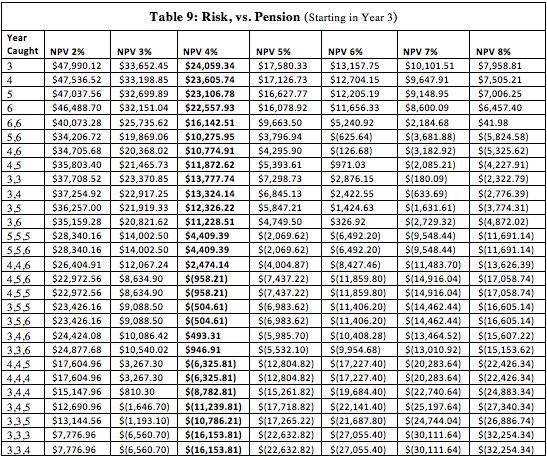
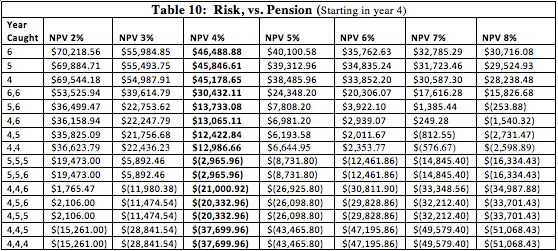
The final set of tables is calculated by subtracting the net present value for loss of wages shown in the appendix from the total net present value of wages given in table 2 and 3, then multiply that by 79%. It is shown earlier in the paper that only 21% of players drafted between the 5th and 11th rounds make it to the majors, so 79% of players drafted between the 5th and 11th round did not make it to the MLB. Tables 11 and 12 show the possible punishment schemes for a Triple-A player that takes steroids, but does not make it on a 40-man roster or meet the criteria for the MLB pension.
.79 (NPV Wages - Loss of Wages - NPV Total Wages)
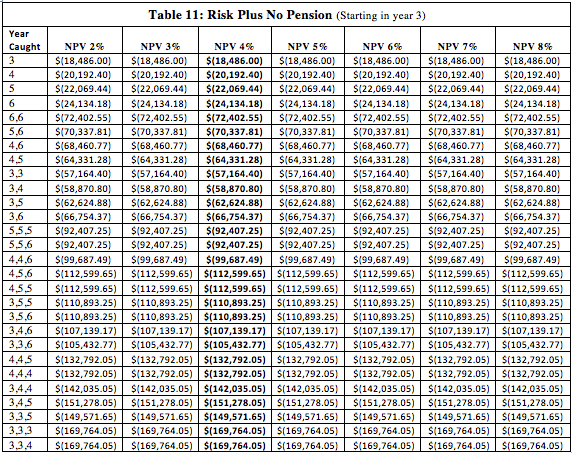
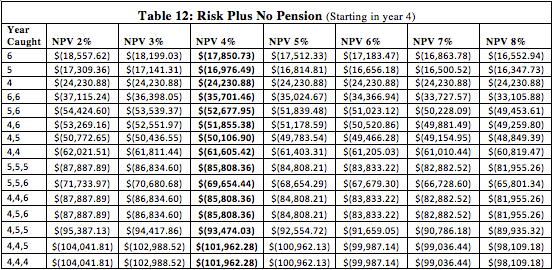
Results
Once all the tables are calculated and set up they can be organized into a two game theory table. Table 13 will use the tables for when the player started taking steroids in year 3. While table 14 will use the tables when the player started taking steroids in year 4. Table 13 will use tables 7, 9, 11 and one table with a value of zero. Table 14 will use 8 10, 12 and one table with a value of zero.
Each tables shows a different set of scenarios. Starting in the top left of tables 13 and 14 displays table 7 and 8. Table 7 and 8 give the net present value for a player under for the scenario that he doesn’t get caught taking steroids and meets the criteria for the MLB pension. The bottom left section of table 13 and 14 displays tables 9 and 10. Tables 9 and 10 show the possible net present values for a player that gets caught taking steroids and meets the criteria for the MLB pension. The bottom right section of table 13 and 14 show the net present value for a player that gets caught taking steroids and doesn’t make the minimum requirements for the MLB pension.
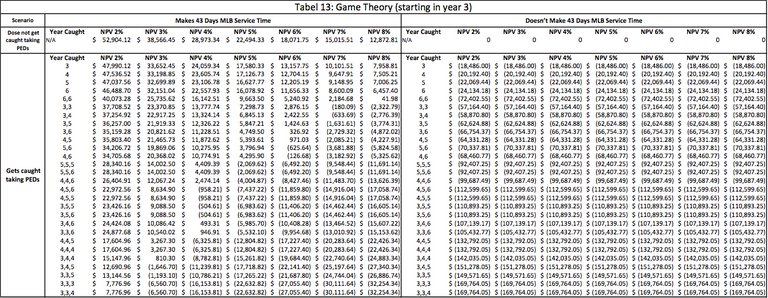

The top right section of table 13 and 14 displays a value of zero, which shows the net present value for a player that doesn’t get caught or doesn’t take steroids and doesn’t meet the criteria for the MLB pension. Any value in the other tables greater then the $0 represents a positive outcome, which means the player will make more money then he would if he didn’t take steroids. Any value less then zero represents a negative outcome, means the player will loss more money then he would if he didn’t take steroids.
As shown in tables 13 and 14, if a player picks to start taking steroids in either his third year or his fourth year in the minors, he should pick his fourth year. In his fourth year he has one less year of being able to be caught, which drastically reduces the possible combination of times he can be caught. The greatest loss for starting in year three at a 4% discount rate is ($169,764.05). The greatest loss for starting in year four at a 4% discount rate is ($101,962.28), which is $67,801.77 less then starting in year 3. Since starting in year three has a greater potential loss then starting in year four, and has a starting in year three has a slightly lower maximum potential of 28,973.34 at the 4 % rate. So starting in year 4 has the value of cheating is $29,362.78, given the player doesn’t receive higher then Minor League pay plus optional assignment pay raise for one season. The best choice would be to start taking steroids in year four, because you risk a smaller amount of future wages and have a higher potential gain then starting in year 3. Another risk in starting to take steroids before year four is that a player has a greater potential to develop enough with out having to resort to performance enhancing drugs to make the majors.
The standard outcome is set at $0, and is for a player that doesn’t get caught taking steroids and doesn’t receive a MLB pension plan. This scenario is also for a player that plays out his Minor League career without taking steroids or any other performance enhancing drugs. The net present value for this scenario is $0 because he has no positive gains or any punishments for breaking MLB drug policies.
The minimum best possible outcome for a Minor League player that takes steroids is, not getting caught and making the criteria to receive a MLB pension. At the 4% discount rate a Minor League player will have a net present value of $29,362.78. This value could be greater depending on how long the Minor League player manages to stay on the 40-man roaster. This scenario is also the most unlikely to happen because of the MLBs rigorous drug testing policies.
The next scenario would be receiving the MLB pension and getting caught. Under this set of scenarios the best outcome is getting caught once in year six if you started taking steroids in year four, this would give the player a net present value $21,311.38. The worst outcome under this scenario is if the player gets caught three times in year 4. Under these conditions the player will have a negative net present value of $4,517.09. If the player stops taking steroids after getting caught twice he will still have a positive net present value of at least $11,859.03. If the player continues taking steroids after getting caught the third time, he risks taking on losses. If the discount rate increases it becomes less profitable to take steroids. At the 8% rate marginal cost out weighs marginal benefits for most scenarios. If the discount rate decreases, marginal benefits are greater then marginal costs for all scenarios.
The next scenario is the worst set of ought comes, getting caught and not receiving the MLB pension plan. Under the different discount rates and the different punishments schemes, all the outcomes are negative. At the 4% discount rate if a player started in year four, the best out come is just getting caught once in year 6, which gives a negative net present value of $17,850.73. The greatest loss at a 4% discount rate is getting caught three times in year 4, which has a negative net present value of $101,962.28.
Comparing the values of starting and getting caught in year 4, it is easier to see how marginal benefits decrease with each offense. Starting in year four at the 4% discount rate, if a player has not bean caught taking PEDs his NPV for cheating is $29,362.78 given he makes the criteria to get the MLB pension. If a player is caught once in his fourth year, his NPV decreases to $45,178.65. If that player is caught a second time, his potential profits drop even further to $12,986.66 and getting caught a third time in his fourth year pushes his NPV to $(37,699.96). Unfortunately $(37,699.96) is not a good representation of getting caught three times in one year. Getting caught that many times in one year, its probably safe to say he didn’t have enough time to meet the MLB service time criteria, so the actual NPV would be $(101,962.28). As it is shown NVP is pushed into the negative on the third offense, but the loss magnified if the pension is not acquired.
A Minor League player will need to be at least a little risk seeking to pursue the scenarios in tables 13 and 14. Unfortunately most players will not weigh their financial incentive to take steroids. Once a player starts taking steroids they are most likely going to focusing on trying to sign a big MLB contract, not trying to snag a pension plan before retiring. If a player does secure a MLB contact, the gets caught and makes pension scenario will become all positive, because one year of minimum Minor League pay is worth more then the net present value of the pension. This is a long shot for most Minor League players and is an extremely risk seeking behavior, but the punishments don’t seem to deter players from taking performance enhancing drugs. The tables above show the minimum amount a Minor League player can make against the current MLB punishment regulations. If the minimum amount a Minor League player can make is positive in many scenarios, adding the minimum MLB contract of about half a million dollars a year or optional assignment pay for more then one season greatly increases incentives. Especially if you have three tries to secure that MLB contact.
Conclusion
In conclusion, there are financial incentives for Minor League players to cheat, but with most things cheating only helps if you are able to win. When a player begins taking steroids depends on how risk seeking that individual is. There are higher potential losses if a player begins taking steroids in year three, over year four, but starting in year three gives a player more chances to secure the pension or a MLB contract.
From what the tables show, it’s financially smart to get clean after getting caught the second time. Even with the punishments there are still financial incentive to continue taking performance enhancing drugs after being caught a second time as long as the player is not caught at least twice in his first year of taking drugs. A recently published article by Sam Miller, an ESPN writer, takes a look at the performance of a small number MLB player that took steroids and are now clean. Unfortunately the sample size is small because not many MLB players take steroids, or at least they don’t get caught taking steroids. The article discovered that the, “small sample of 13 [MLB] players who were caught doing PEDs in the past five years collectively improved after they presumably got clean.” (Miller, Sam) Information like that just increases the incentive for players, if a player can take performance-enhancing drugs tell he is caught twice, take the suspensions and fines and continue to improve after he is clean. Since performance enhancing drugs offer a shot at greater pay and, don’t offer any risk besides the current MLB suspension policies and public embracement for cheating. Minor League players should take performance enhancing drugs tell they are caught twice, and then play out the rest of their careers.
Bibliography
Blank, Jeff. "Minor League Salary." Sports Law Blog. N.p., n.d. Web. http://www.sportslawblogger.com/baseball/salary-information/minor-league-salary/.
Copel, Larry. "Life Expectancy in the USA Hits a Record High." USA Today. Gannett Satellite Information Network, 09 Oct. 2014. Web. https://www.usatoday.com/story/news/nation/2014/10/08/us-life-expectancy-hits-record-high/16874039/.
"Glossary | Service Time | MLB.com." Major League Baseball. N.p., n.d. Web. http://m.mlb.com/glossary/transactions/service-time.
Hunt, Jason. "MLB Roster Rules: The 40 Man Roster." MLB Daily Dish. MLB Daily Dish, 04 Sept. 2011. Web. http://www.mlbdailydish.com/2011/9/4/2400827/mlb-roster-rules-40-man-roster.
"Major League Uniform Contract." N.p., n.d. Web. http://rotoauthority.blogs.com/files/mlb-contract.pdf+.
Miller, Sam. "'Roids to Ruin? Turns Out, PED Punishments Aren't a Deterrent." ESPN. ESPN Internet Ventures, 19 Apr. 2017. Web. http://www.espn.com/mlb/story/_/id/19192130/roids-ruin-turns-ped-punishments-deterrent
OKennedy, Patrick. "What Are the Odds of Making It to the Majors?" Bless You Boys. Bless You Boys, 05 Mar. 2013. Web. 07 May 2017. http://www.blessyouboys.com/2013/3/5/3977782/what-are-the-odds-of-making-it-to-the-major-leagues
Riddix, Mark. "Top Pro Athlete Pension Plans." Investopedia. N.p., 14 July 2010. Web. http://www.investopedia.com/financial-edge/0710/top-pro-athlete-pension-plans.aspx.
R.J. Anderson @r_j_anderson. "What to Know about MLB September Call Ups, Roster Expansions and Playoff Rosters." CBSSports.com. CBSSports, 01 Sept. 2016. Web. http://www.cbssports.com/mlb/news/what-to-know-about-mlb-september-call-ups-roster-expansions-and-playoff-rosters/.
Rubin, Adam. "Jenrry Mejia First Player to Get Permanent Ban for 3rd Positive PED Test." ESPN. ESPN Internet Ventures, 13 Feb. 2016. Web. 07 May 2017. http://www.espn.com/mlb/story/_/id/14768114/jenrry-mejia-new-york-mets-suspended-permanently-mlb-third-positive-ped-test.
The Jay. "The 40-Man Roster: How Does It Work?" Brew Crew Ball. Brew Crew Ball, 04 Jan. 2009. Web. http://www.brewcrewball.com/2009/1/4/703125/the-40-man-roster-how-does.
"2012-2016 BASIC AGREEMENT." N.p., n.d. Web. http://mlb.mlb.com/pa/pdf/cba_english.pdf+.
Appendix
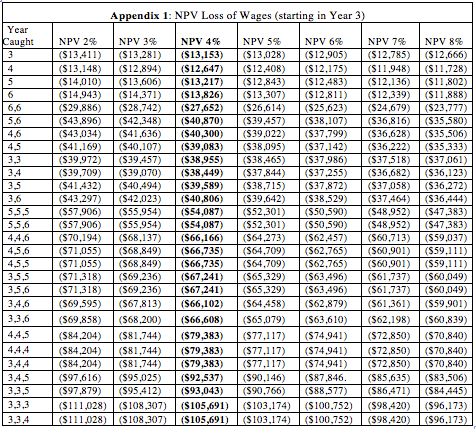
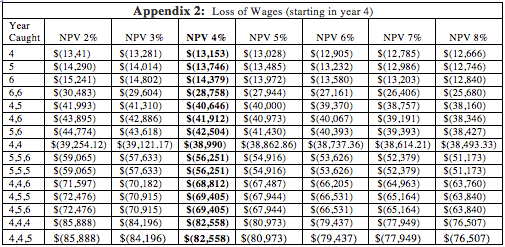
Congratulations @spike-spiegel! You have completed some achievement on Steemit and have been rewarded with new badge(s) :
Click on any badge to view your own Board of Honnor on SteemitBoard.
For more information about SteemitBoard, click here
If you no longer want to receive notifications, reply to this comment with the word
STOPBy upvoting this notification, you can help all Steemit users. Learn how here!
Congratulations @spike-spiegel! You have received a personal award!
Click on the badge to view your Board of Honor.
Do not miss the last post from @steemitboard!
Participate in the SteemitBoard World Cup Contest!
Collect World Cup badges and win free SBD
Support the Gold Sponsors of the contest: @good-karma and @lukestokes
Congratulations @spike-spiegel! You received a personal award!
You can view your badges on your Steem Board and compare to others on the Steem Ranking
Vote for @Steemitboard as a witness to get one more award and increased upvotes!